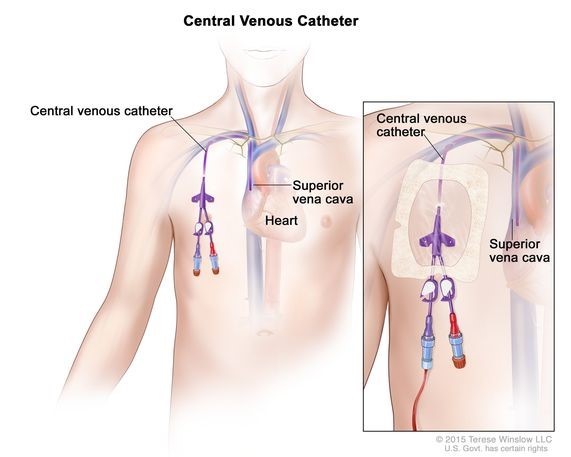A nurse is reviewing the plan of care for a group of clients. The nurse should identify that informed consent is required for which of the following procedures?
Irrigation of a wound with antibiotic solution
Administration of an iron injection using Z-track technique
Placement of a central venous catheter
Insertion of a nasogastric tube
The Correct Answer is C
Informed consent is a legal and ethical requirement for certain medical procedures. It involves providing the client with clear and comprehensive information about the procedure, including its risks, benefits, alternatives, and expected outcomes. The client must understand the information provided and voluntarily give their consent before the procedure can be performed.
Placement of a central venous catheter is an invasive procedure that carries risks and potential complications, making it necessary to obtain informed consent from the client.

Wound irrigation with an antibiotic solution is a standard nursing intervention for wound care and does not usually involve invasive procedures. Informed consent is not typically required for this procedure.
The administration of an iron injection using the Z-track technique is a standard nursing procedure. While it involves an injection, it is not typically considered an invasive procedure that would require informed consent.
Insertion of a nasogastric tube is a common procedure that involves passing a tube through the nose and into the stomach for various purposes, such as feeding, decompression, or medication administration. While it is an invasive procedure, it is often performed in emergency or critical care situations where the client's immediate well-being takes precedence. Informed consent may not be feasible or necessary in these situations, depending on the context and urgency.
Nursing Test Bank
Naxlex Comprehensive Predictor Exams
Related Questions
Correct Answer is A
Explanation
An incident report is a tool used to document any unexpected or adverse event that occurs in the healthcare setting. It is important to report incidents to ensure proper investigation, analysis, and implementation of measures to prevent future occurrences.
In this example, the incident involves an error with an electronic IV pump resulting in the delivery of an incorrect amount of fluid, which can have serious implications for the client's safety and well-being.
The other examples listed may require further actions but may not necessarily require an incident report:
- A nurse discovers that a client's family member has administered a PCA dose: While it is concerning that a client's family member administered a patient-controlled analgesia (PCA) dose, it is more appropriate to address this situation through immediate intervention, education, and communication with the healthcare provider. An incident report may not be necessary unless there are further complications or system issues related to this incident.
- A nurse observes another nurse remove wrist restraints one at a time from a client who is currently calm: While the observation of improper restraint removal raises concerns about proper restraint protocol, it is more appropriate to address this situation through immediate intervention and communication with the involved nurse and healthcare provider. Depending on the severity of the situation, an incident report may or may not be warranted, but it is not the primary action in this case.
- A nurse observes a client vomiting after receiving an oral pain medication: While it is important to assess and address the client's condition and any adverse reactions, such as vomiting after receiving medication, it may not necessarily require an incident report. The nurse should assess the client, notify the healthcare provider, and document the incident appropriately in the client's medical record.
Correct Answer is A
Explanation
A.Giving change-of-shift report to a nurse outside the client's room ensures that client information is shared in a private, secure setting, reducing the risk of unauthorized individuals overhearing sensitive information.
B.While sharing information with staff involved in the client's care is generally acceptable, discussing detailed prognosis with assistive personnel (who may not have a need-to-know role) is inappropriate. Confidential information should only be shared with those directly involved in the patient's care as part of the care team.
C.This is a clear violation of confidentiality, as it exposes the client's private health information to anyone who may access the room.
D.This is a breach of confidentiality, as the information could be accessed by unauthorized individuals. The appropriate way to dispose of confidential information is to shred it or return it to the medical record.
Whether you are a student looking to ace your exams or a practicing nurse seeking to enhance your expertise , our nursing education contents will empower you with the confidence and competence to make a difference in the lives of patients and become a respected leader in the healthcare field.
Visit Naxlex, invest in your future and unlock endless possibilities with our unparalleled nursing education contents today
Report Wrong Answer on the Current Question
Do you disagree with the answer? If yes, what is your expected answer? Explain.
Kindly be descriptive with the issue you are facing.
